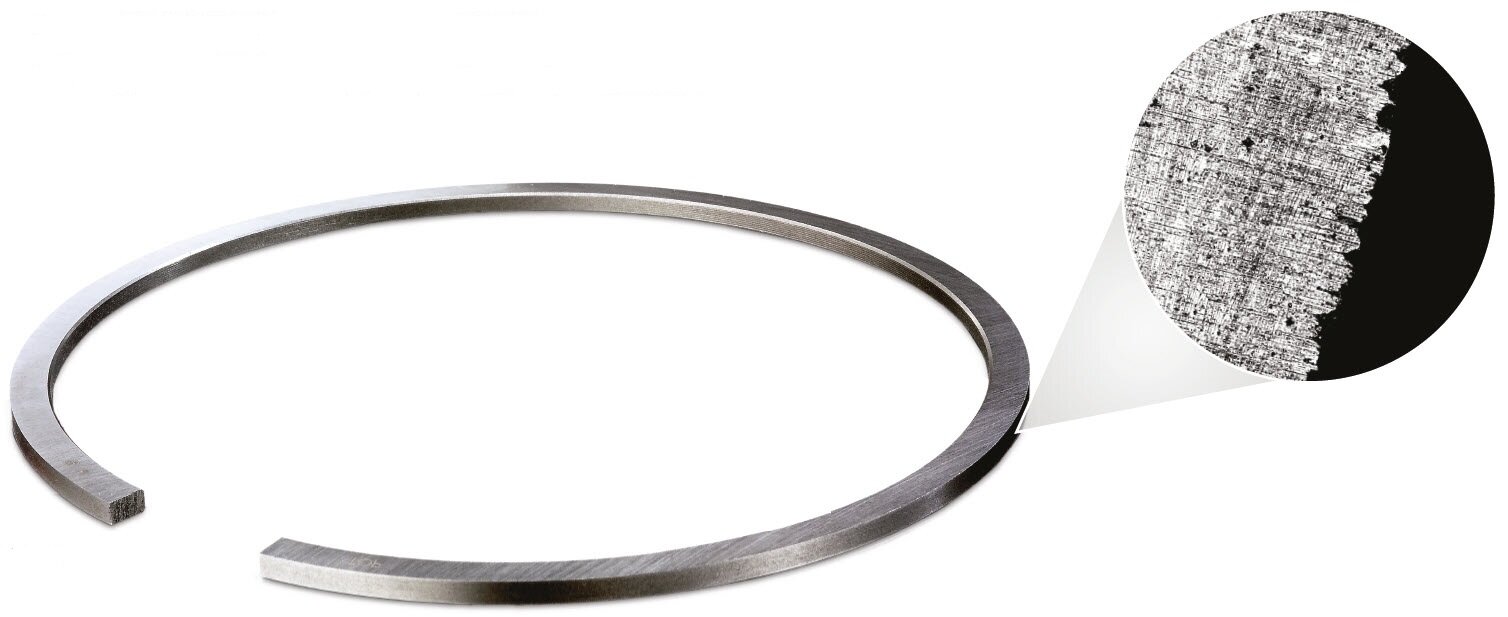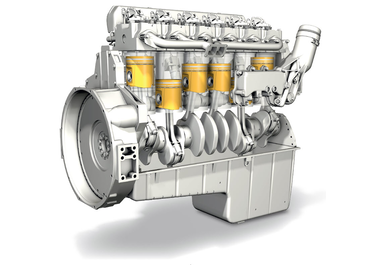
Piston damage
increased oil consumption - 2
Information on diagnostics
What defects are indicated by piston rings with severe radial wear? What leads to fuel flooding and what can the consequences be? What do you need to be aware of during engine reconditioning? What can happen if blunt honing stones are used for honing or if honing is carried out with excessive force? What is meant by peak folding? What faults are indicated by asymmetrical piston wear patterns? You can find the information here.
Wear on pistons, piston rings and cylinders caused by fuel flooding
Description of the damage
- Severe signs of wear on the piston top land and piston skirt.
- Friction marks on the piston skirt, characteristic of dry running due to fuel flooding.
- Piston rings display severe radial wear (Fig. 1). Both webs (support surfaces) on the oil control ring have been worn down (Fig. 2). By way of comparison in Fig. 3: profile of a new and worn oil control ring (double-bevelled spiral expander ring).
- Increased oil consumption.
Damage assessment
Fuel flooding due to abnormal combustion always damages the oil film. This leads to a higher level of mixed friction and increased radial wear on the piston rings within a short period. The characteristic fuel friction only occurs after the oil film has been so badly impaired by the fuel that lubrication is then insufficient (refer to the chapter entitled “Dry running damage due to lack of lubrication caused by fuel flooding”). The increasingly ineffective lubrication results in high levels of wear on the piston rings, piston ring grooves and cylinder sliding surfaces.
In the initial stages the piston skirt is damaged to a lesser degree, as it is regularly supplied with new oil that is still capable of providing lubrication from the crankshaft drive. Once the abraded particles from the moving area become mixed with the lubricating oil and the lubricating oil loses its load-bearing ability as a result of increasing oil dilution, the wear will spread to all bearing points in the engine. This affects the piston pins and crankshaft journals in particular.
Possible causes for the damage
- Frequent operation over short distances and resulting oil dilution with fuel.
- Coolant admixture in engine oil.
- Poor engine oil grade.
- Fuel flooding due to incomplete combustion as a result of malfunctions in the mixture preparation.
- Malfunctions in ignition system (misfiring).
- Insufficient compression pressure or poor filling through worn or fractured piston rings.
- Incorrect piston protrusion dimension: the piston strikes against the cylinder head. On diesel engines with direct injection, the resulting vibrations cause uncontrolled injection of fuel from the injection nozzles and thus fuel flooding in the cylinder (refer to the chapter entitled “Impact marks on the piston head”).
- Poor filling through clogged-up air filter.
- Faulty and leaking injection nozzles.
- Faulty or incorrectly set fuel injection pump.
- Incorrectly routed injection lines (vibrations).
- Poor charging through faulty or worn turbocharger.
- Poor fuel quality (poor self-ignition and incomplete combustion).
Piston ring wear soon after engine reconditioning
Description of the damage
- No damage or wear on piston.
- Superficial inspection of piston rings reveals no wear marks, however, closer inspection reveals abnormal wear on the oil-scraping ring edges, mostly on the bottom ring edges (see magnified image).
- Tangible burr on the bottom edge of the piston ring running surface.
Damage assessment
The worn piston ring edges lead to high hydrodynamic forces (Fig. 2) between the running surfaces of the piston rings and the cylinder running surface as a result of the formation of an oil wedge.
The piston rings float on the oil film during the upward/ downward motion of the piston and are lifted off slightly from the cylinder running surface. In this way, an increased quantity of lubricating oil reaches the combustion chamber where it is burned.
The burring is caused if the piston rings are refitted in less than ideal conditions after the engine reconditioning. Themain reasons are insufficient or inappropriate cylinder finishing. If blunt honing stones are used for finish honing or excessive pressure is applied during honing, burrs and elevations form on the cylinder wall. These metal edges are folded over in the direction of machining (Fig. 3). This is referred to as the “peak folding formation” and causes increased friction during the running-in phase, preventing engine oil from becoming deposited in the fine graphite veins.
If these burrs are not removed in a final machining process referred to as plateau honing, this will result in premature wear at the piston ring edges during the running-in phase. The piston rings then take on the undesired duty of wearing away the folded peaks and cleaning the graphite veins. However, this leads to wear on the piston ring edges and the formation of burrs. From experience, burrs created in this way on the piston ring edge can only be run off with great difficulty. The damaged piston rings need to be replaced.
A second set of piston rings installed as replacement rings will encounter much better, virtually normal operating conditions. This is because the first set of piston rings will have removed most of the disadvantageous edge layer on the cylinder running surface (the “peak folding formation”) through wear. The oil consumption will return to normal levels after replacing the piston rings. In many cases this is incorrectly attributed to poor-quality materials in the first piston rings that were installed.
The microscopic enlargement in Fig. 4 shows the bent-over peaks through a section of the cylinder surface after the disadvantageous honing of the cylinder running surface (peak folding). Fig. 5 shows the surface after plateau honing. The burrs and peaks have been mostly removed, and the graphite veins have been exposed. The piston rings will encounter good conditions for running-in and should therefore provide a long service life. Hone-brushing the surface to create the plateau finish delivers particularly good results.
Asymmetrical piston wear pattern
Description of the damage
Fig. 1:
- Asymmetrical wear pattern on piston over its entire height.
- Top land on left of piston above the piston pin bore and on opposite side at lower edge of piston rubbed bare.
- Uneven wear pattern on compression ring.
Fig. 2:
Piston running skew, with the wear mainly on the lower, right-hand edge of the piston at the recess for the cooling-oil nozzle and under the piston pin bore.
Damage assessment
This type of asymmetrical wear pattern indicates that the piston has not been running perfectly straight in the cylinder bore and that the piston pin axis and the crankshaft axis are not parallel to each other. The piston rings cannot perform their sealing function properly due to the lack of proper contact with the cylinder. The hot combustion gases blow through and heat up the piston rings and the cylinder wall excessively. This weakens the oil film, which may result in a seizure due to lack of lubrication. As the piston is running skew in the cylinder, its reciprocating movement creates a pumping effect at the piston rings, which pumps oil into thecombustion chamber and thus increases oil consumption. Under certain conditions an axial thrust can be applied to the piston pin, which can lead to wear or fracturing of the piston pin circlips (refer to the chapter entitled “Piston damage caused by broken piston pin circlips”).
Possible causes for the damage
- Bent or twisted connecting rods.
- Connecting rod eyes bored at an angle.
- Cylinder bore not perpendicular to crankshaft axis.
- Individual cylinders not installed straight (distorted during installation).
- Connecting rod pins not parallel with crankshaft axis.
- Connecting rod eye bored at an angle (axes not parallel).
- Excessive connecting rod bearing clearance, particularly in conjunction with asymmetrical connecting rods (centre offset between connecting rod eye and the large connecting rod bearing).
